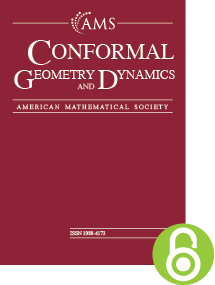Expansion complexes for finite subdivision rules. II
HTML articles powered by AMS MathViewer
- by J. W. Cannon, W. J. Floyd and W. R. Parry
- Conform. Geom. Dyn. 10 (2006), 326-354
- DOI: https://doi.org/10.1090/S1088-4173-06-00127-5
- Published electronically: December 6, 2006
- PDF | Request permission
Abstract:
This paper gives applications of earlier work of the authors on the use of expansion complexes for studying conformality of finite subdivision rules. The first application is that a one-tile rotationally invariant finite subdivision rule (with bounded valence and mesh approaching $0$) has an invariant partial conformal structure, and hence is conformal. The paper next considers one-tile single valence finite subdivision rules. It is shown that an expansion map for such a finite subdivision rule can be conjugated to a linear map, and that the finite subdivision rule is conformal exactly when this linear map is either a dilation or has eigenvalues that are not real. Finally, an example is given of an irreducible finite subdivision rule that has a parabolic expansion complex and a hyperbolic expansion complex.References
- A. F. Beardon, A primer on Riemann surfaces, London Mathematical Society Lecture Note Series, vol. 78, Cambridge University Press, Cambridge, 1984. MR 808581 Bl E. Blanc, Propriétés génériques des laminations, Ph.D. thesis, Université Lyon-1, 2001.
- Philip L. Bowers and Kenneth Stephenson, A “regular” pentagonal tiling of the plane, Conform. Geom. Dyn. 1 (1997), 58–68. MR 1479069, DOI 10.1090/S1088-4173-97-00014-3
- James W. Cannon, The combinatorial Riemann mapping theorem, Acta Math. 173 (1994), no. 2, 155–234. MR 1301392, DOI 10.1007/BF02398434
- J. W. Cannon, W. J. Floyd, and W. R. Parry, Squaring rectangles: the finite Riemann mapping theorem, The mathematical legacy of Wilhelm Magnus: groups, geometry and special functions (Brooklyn, NY, 1992) Contemp. Math., vol. 169, Amer. Math. Soc., Providence, RI, 1994, pp. 133–212. MR 1292901, DOI 10.1090/conm/169/01656
- J. W. Cannon, W. J. Floyd, and W. R. Parry, Sufficiently rich families of planar rings, Ann. Acad. Sci. Fenn. Math. 24 (1999), no. 2, 265–304. MR 1724092
- J. W. Cannon, W. J. Floyd, and W. R. Parry, Finite subdivision rules, Conform. Geom. Dyn. 5 (2001), 153–196. MR 1875951, DOI 10.1090/S1088-4173-01-00055-8
- J. W. Cannon, W. J. Floyd, R. Kenyon, and W. R. Parry, Constructing rational maps from subdivision rules, Conform. Geom. Dyn. 7 (2003), 76–102. MR 1992038, DOI 10.1090/S1088-4173-03-00082-1
- J. W. Cannon, W. J. Floyd, and W. R. Parry, Expansion complexes for finite subdivision rules. I, Conform. Geom. Dyn. 10 (2006), 63–99. MR 2218641, DOI 10.1090/S1088-4173-06-00126-3
- James W. Cannon, William J. Floyd, and Walter R. Parry, Combinatorially regular polyomino tilings, Discrete Comput. Geom. 35 (2006), no. 2, 269–285. MR 2195055, DOI 10.1007/s00454-005-1205-2
- J. W. Cannon and E. L. Swenson, Recognizing constant curvature discrete groups in dimension $3$, Trans. Amer. Math. Soc. 350 (1998), no. 2, 809–849. MR 1458317, DOI 10.1090/S0002-9947-98-02107-2
- Adrian Constantin and Boris Kolev, The theorem of Kerékjártó on periodic homeomorphisms of the disc and the sphere, Enseign. Math. (2) 40 (1994), no. 3-4, 193–204. MR 1309126
- Étienne Ghys, Laminations par surfaces de Riemann, Dynamique et géométrie complexes (Lyon, 1997) Panor. Synthèses, vol. 8, Soc. Math. France, Paris, 1999, pp. ix, xi, 49–95 (French, with English and French summaries). MR 1760843
- Zheng-Xu He and O. Schramm, Hyperbolic and parabolic packings, Discrete Comput. Geom. 14 (1995), no. 2, 123–149. MR 1331923, DOI 10.1007/BF02570699
- Richard Kenyon, Inflationary tilings with a similarity structure, Comment. Math. Helv. 69 (1994), no. 2, 169–198. MR 1282366, DOI 10.1007/BF02564481
- Zeev Nehari, Conformal mapping, McGraw-Hill Book Co., Inc., New York-Toronto-London, 1952. MR 0045823 S K. Stephenson, CirclePack, software, available from http://www.math.utk.edu/~kens.
Bibliographic Information
- J. W. Cannon
- Affiliation: Department of Mathematics, Brigham Young University, Provo, Utah 84602
- Email: cannon@math.byu.edu
- W. J. Floyd
- Affiliation: Department of Mathematics, Virginia Tech, Blacksburg, Virginia 24061
- MR Author ID: 67750
- Email: floyd@math.vt.edu
- W. R. Parry
- Affiliation: Department of Mathematics, Eastern Michigan University, Ypsilanti, Michigan 48197
- MR Author ID: 136390
- Email: walter.parry@emich.edu
- Received by editor(s): November 22, 2004
- Published electronically: December 6, 2006
- Additional Notes: This research was supported in part by NSF grants DMS-9803868, DMS-9971783, DMS-10104030, and DMS-0203902.
- © Copyright 2006
American Mathematical Society
The copyright for this article reverts to public domain 28 years after publication. - Journal: Conform. Geom. Dyn. 10 (2006), 326-354
- MSC (2000): Primary 30F45, 52C20; Secondary 20F67, 52C20
- DOI: https://doi.org/10.1090/S1088-4173-06-00127-5
- MathSciNet review: 2268483


